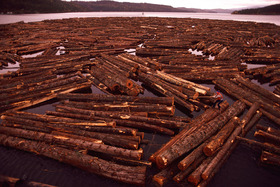The WPJ
THE WORLD PROPERTY JOURNALReal Estate Facts Not Fiction
Residential Real Estate News

Timber Industry Begins Rebound, Aided by Recent US Housing Recovery
Residential News » North America Residential News Edition | By Hortense Leon | February 5, 2013 8:00 AM ET
 The fortunes of the timber industry wax and wane with that of the housing industry, so it isn't surprising that as the housing industry begins its recovery, the timber industry is recovering as well.
The fortunes of the timber industry wax and wane with that of the housing industry, so it isn't surprising that as the housing industry begins its recovery, the timber industry is recovering as well.The National Council of Real Estate Investment Fiduciaries (NCREIF)'s timber index, which includes 443 investment grade properties with over 15 million acres and more than $26 billion in market value is a good barometer for the industry, says Jeffrey Havsy, research director at NCREIF in Chicago.
According to the fourth quarter 2012 report on the timber index by NCREIF, the total return for the category was 5.92%, the highest since fourth quarter 2007. The return was split between 5.33% appreciation and .59% income. For the year, timberland had returns of 7.76%, split between 2.68% in income and 4.97% in appreciation.
NCREIF's timber index has 317 properties in the South, 86 in the Pacific Northwest, 15 in the Lake States and 20 in the Northeast. While there may be a lot of timberland in other states, it is not covered by NCREIF's timber index, because the land is owned by REITs, such as Plum Creek or Weyerhaeuser, or large, private owners, instead of investment managers, says Havsy.
The last time appreciation in the timber index was greater than 5% was in fourth quarter 2007 when timberland appreciated by 8.71%, according to the NCREIF report. Even though the index had three consecutive quarters of positive appreciation, it remains more than 5% below its previous peak. The Pacific Northwest continues to be the strongest region with a total return of 10.02% of which .97% was income. This marks the sixth consecutive quarter in which it was the leading region in the index, according to the report.
The lake states (Minnesota, Michigan and Wisconsin) were the worst performing region with a total return of 1.68%. The fourth quarter of 2012 marked the third consecutive quarter that all four regions had positive appreciation, according to NCREIF. There hasn't been three consecutive quarters with all regions having positive appreciation since the first quarter of 2000.
Appreciation, although roughly 5% in the fourth quarter of 2012, was barely positive in the two previous quarters and had been negative nine of the 11 quarters before that, says Havsy. In the first quarter of 2009, appreciation was about 3.5%, he says. For the last three and a half years, the values of the properties in the index were either bouncing along or negative, says Havsy.
The Northwest has more hardwood timber which is used in housing construction, while in the South, the timber is turned into pulp for making paper, says Havsy. The South has not rebounded as much as the Pacific Northwest hardwood forests have, he says. "The export market has helped the Pacific Northwest," says Havsy. "It has been the biggest gainer with regard to exports," he says.
Mary Ellen Aronow, senior forest economist at Hancock Timber Resource Group and chair of the NCREIF Timberland Committee, says that timberland growers in the US have gone through a long period waiting for the housing market to recover. "Chinese log and lumber buyers provided an outlet for US timber grown near western coastal ports, but timber too far from ports has remained in the forest, waiting for a return in domestic demand," she says.
"(In 2012), US southern timber owners were still facing...low prices for their timber. Now, with US housing starts reaching a post-recession high of 954,000 annual units in December--all eyes are on the US market again," says Aronow. "Early gains in production and prices have accrued to US solid wood producers (as opposed to pulp producers), who are experiencing sharp increases in profits as rising demand falls on a much-consolidated industry," she says.
Sign Up Free | The WPJ Weekly Newsletter
Relevant real estate news.
Actionable market intelligence.
Right to your inbox every week.
Real Estate Listings Showcase
Related News Stories
Residential Real Estate Headlines
- U.S. Homebuyer Median Down Payment Hits Record $67,500
- New Home Sales in America Jump in July
- Zombie Foreclosures in U.S. Decline in Q3, Reaching Lowest Levels Since 2021
- U.S. Home Sales Uptick in July, First Time in 5 Months
- Italy's 2024 Tourism Boom, Tax Perks Energizing Local Home Sales
- U.S. Builder Confidence Moves Lower in August
- U.S. Mortgage Rates Dip to Lowest Levels in Over a Year in Mid-August
- DOJ, NAR Commission Payment Changes Take Effect August Seventeenth
- U.S. Foreclosures Jump 15 Percent Month Over Month in July
- Over 2.6 Million Western U.S. Homes at Risk of Wildfire Damage in 2024
- Opportunity Zone Homes Across America Enjoy Price Gains in Q2
- Orange County, Chicago, Phoenix, and Washington DC Become Trillion Dollar U.S. Housing Markets
- Los Angeles, San Diego and New York Have Highest Concentrations of Renter Households
- Greater Las Vegas Area Home Sales, Prices Rise in July
- People Are Still Moving at Scale From Fire-Prone to Heat and Flood-Prone America
- Buyer Agent Commission Rates Declining in Wake of NAR DOJ Settlement in 2024
- Miami's Brickell Office Market Hits Record $200 Square Foot Rents in 2024
- U.S. Pending Home Sales Rise 5 Percent in June, First Time in 3 Months
- California Home Sales Dip 3 Percent Annually in June
- Macau's Residential Sales Continue to Decline in 2024
- Greater Miami Residential Sales Slide 13 Percent Annually in June
- Greater Orlando Area Home Sales Down 11 Percent in June
- U.S. Home Sales Slipped Dipped 5.4 Percent in June
- Foreign Investment in U.S. Residential Properties Plummet 21 Percent Over Last 12 Months
- U.S. Housing Rents Growing Fastest in Unexpected Places in 2024
- U.S. Mortgage Rates Tick Down in Mid- July
- Mortgage Bankers Oppose Biden Campaign's Nationwide Rent Control Proposal
- Apartment Building Permits in U.S. Drop Nearly 30 Percent Since Pandemic
- Global Home Price Growth Accelerates in 2024
- Las Vegas Area Condo Prices Rise 7.3 Percent Annually in June
- America's Home Affordability Issues Worsen in Mid 2024
- U.S. Mortgage Applications Dip in Late June
- Greater Palm Beach Area Residential Sales Dip 7 Percent in May
- Typical U.S. Home Selling Less Than List Price in June
- Mortgage Rates in U.S. Dip in Late June
- U.S. Pending Home Sales Fall to All-time Low in May
- Greater Miami Home, Condo Prices Continue to Rise in May
- Ireland Home Prices Rise in Q2, Driven by Inventory Shortages
- Home Sales in U.S. Dip for Third Consecutive Month in May
- Homebuilder Confidence in the U.S. Drops to 2024 Low in June
Reader Poll
Marketplace Links
This website uses cookies to improve user experience. By using our website you consent in accordance with our Cookie Policy. Read More





